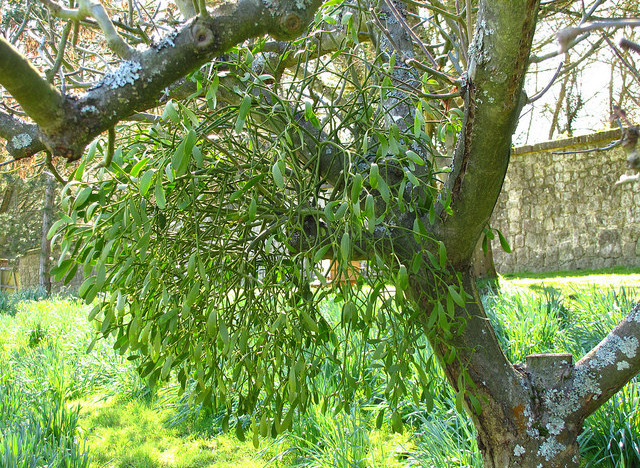You know the drill: get caught under the mistletoe, and someone can steal a kiss. A holiday-centric, heart-fluttering concept, but not many know why and what the berried ball of green hanging from above is, anyways. There are a few legends and stories out there about how this intriguing tradition came to be and most of them stem from the alleged medicinal properties of mistletoe. But be forewarned: mistletoe can be harmful if used improperly. It can cause stomach upset and if a small child ingests it, it can be quite dangerous.

Flickr user Mostly Dans
The Norse believe that mistletoe is linked to the goddess of love, as its medicine saved her son. The Druids believed that mistletoe could perform miracles, cured illness and would protect against witchcraft. They believed that kissing under this sacred plant would keep them safe from evil. The Druids even observed a tradition that when enemies met in the forest under a canopy of mistletoe, they would put down their weapons and wait a day to fight. We wonder if this sign of truce and goodwill is where the modern day kissing ball observance stemmed from?
These legends were born from the European variety of mistletoe, Viscum album. With its thick, dark green leaves and white, sticky berries, it is the one that we commonly associate as the original kissing ball during the holidays. What you normally find at your local market during the holidays probably won't be the European type, but rather the Northern American Mistletoe, Phoradendron flavescens, which grows like crazy up and down the East Coast. Mistletoe grows within the crooks of other plants. It attaches itself to trees and shrubs by grasping into the bark of unsuspecting hosts and absorbing their nutrients. However, mistletoe also photosynthesizes meaning that it is half parasitic, or hemi-parasitic, because it can still produce some of its own nutrients. Once mistletoe gets a hold of its host, it can reduce its growth and can kill it with heavy infestation. Normally you find the European varieties hanging out on apple or oak trees, and in North America you can see mistletoe hanging out on spruce or fir evergreens. Even though mistletoe is hemi-parasidic, they can have a positive effect on biodiversity by providing some necessities for many an animal depending on it for food. In particular, birds are quite attracted to the berries, chomping on them and then spreading their seeds all over the forest after ingestion -- yes, we're talking about bird droppings. That explains the Anglo-Saxon meaning of the word "mistletoe," where "mistle" means dung, and "toe" is used to describe a twig or branch. So mistletoe means dung twig, and suddenly the whole kissing underneath it doesn't sound as appealing, huh?
At least with all this information you will have some verbal ammunition in case there is an awkward silence after the kiss that might have taken you by surprise.
Have something to say? Check out HuffPost Home on Twitter, Facebook, Pinterest, Tumblr and Instagram.
**
Do you have a home story idea or tip? Email us at homesubmissions@huffingtonpost.com. (PR pitches sent to this address will be ignored.)